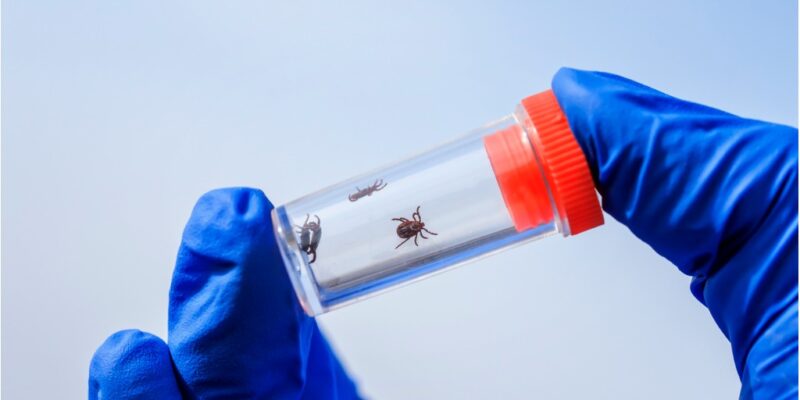
The four most common tick species found in New England are American dog ticks, brown dog ticks, black-legged (deer) ticks, and lone star ticks. The highest risk of being bitten by a tick is during spring and summer. Infestations have been on the rise here over the past few years, which is a concern for pest professionals and homeowners alike. All four species pose a risk to humans.
A Year-Round Threat
Data from the CDC has shown that national Lyme disease rates have increased steadily, and New England has shown the biggest increase in cases and overall infections.
Ticks have proven to be a year-round issue for people in New England. Modern Pest can help you stay safer when you’re at home and have Homecare Mosquito, Flea, and Tick service, but you’re still at risk when you’re out in nature. The CDC advises avoiding brushy, wooded areas, tall grass, and leaf litter. You should also do a full body check of people and pets when you come home.
Click here to call Modern and stop ticks from spreading disease!
The Rise Babesiosis
In addition to Lyme disease, another, lesser-known tick-borne disease is on the rise. Babesiosis is similar to malaria and was first discovered in the U.S. over 50 years ago on Nantucket, Massachusetts. It’s now found in all six New England states.
Babesiosis is carried by black-legged (deer) ticks. Some cases are asymptomatic, but about 80% of cases present symptoms such as chills, fever, and muscle pain. Extreme cases of babesiosis can be fatal, especially in the immunocompromised and elderly.
Dr. Edouard Vannier of Tufts Medical Center credits the rise of babesiosis to many factors. He emphasizes that the spread is accelerated by warmer temperatures. “So, there is possibly an impact of climate change on this spread northward,” he told WBUR’s Irina Matchavariani.
The Ticks of New England
So, what are the differences between the four most common species, and what diseases does each one carry?
American Dog Tick
Description
The American dog tick, or wood tick, is typically reddish-brown with gray and silver markings on its dorsal shields.
Unfed females are typically 5 mm long and are slightly larger than males, which are about 3.6 mm long. Females are normally very flat in appearance unless they are engorged with blood, in which case they can enlarge up to 15 mm long and 10 mm wide.
This tick is usually found in the United States, east of the Rocky Mountains. It can also be found in some parts of Canada, Mexico, and the Pacific Northwest.
Diseases
Tularemia- Symptoms sometimes include a skin ulcer at the site of the bite, and swollen glands usually in the armpit or groin.
Rocky Mountain spotted fever- Early indicators include spotted rashes, confusion, and flu-like symptoms such as fever, chills, headache, nausea, and vomiting.
Brown Dog Tick
Description
The adult brown dog tick is reddish-brown and lacks any ornamentation. When fully fed, the body stretches and changes from reddish-brown to a more blue-gray.
They are 1/8 – 3/16″ in length. Larva have six legs, while nymphs and adults have eight legs. Females increase in size dramatically when engorged from feeding, while males only stop take small meals and don’t get as large.
Brown dog ticks are most commonly found in warmer climates. However, they can complete their entire lifecycle indoors, so they are found in colder climates as well.
Diseases
Rocky Mountain spotted fever- Early indicators include spotted rashes, confusion, and flu-like symptoms such as fever, chills, headache, nausea, and vomiting.
Call 1-800-323-7378 to schedule Homecare Mosquito, Flea, and Tick service now!
Black-legged (Deer) Tick
Description
The black-legged, or deer, tick is named for its black legs. Its body is pale in color, and can be recognized by the small size and reddish dorsal area.
Females have a shorter dorsal plate and a tear-drop shape. Males are smaller with a round dorsal plate that covers most of their body.
They can be found in the northeastern and upper midwestern United States.
Diseases
Lyme disease- Early on, the symptoms are usually fever, chills, body aches, fatigue, headaches, and a stiff neck.
Anaplasmosis- Symptoms commonly include fever, headache, chills, nausea, cough, and muscle aches and pains.
Ehrlichiosis- Common symptoms include fever, headache, nausea, vomiting, and cough.
Babesiosis- Symptoms include weakness, fatigue, fevers, jaundice, hemobglobinuria (ruptured red blood vessels that often cause pink urine), and anemia.
Powassan disease- Although many people develop no signs of the virus, symptoms can include fever, headache, vomiting, weakness, confusion, loss of coordination, speech difficulties, and seizures.
Lone Star Tick
Description
Lone star ticks are named for the single white spot on the backs of the adult females. The spot can vary from cream to bronze/gold and can even appear iridescent at close range.
Females are about 1/4″ long, and 1/2″ or longer when fully engorged.
They can be found in the southeastern and eastern United States.
Diseases
Ehrlichiosis- Common symptoms include fever, headache, nausea, vomiting, and cough
Tularemia- Symptoms sometimes include a skin ulcer at the site of the bite, and swollen glands usually in the armpit or groin.
STARI (southern tick-associated rash illness)- Symptoms include a red, expanding, bull’s eye rash, fatigue, headache, fever, and muscle pains.
Alpha-gal allergy- Humans that contract the alpha-gal carbohydrate from Lone Star ticks develop an allergy to mammalian meat, but can still consume fish and poultry.
The Modern Solution
Modern Pest can help protect your family from the dangers of tick-borne illness. Modern’s Homecare Mosquito, Flea, and Tick service protects against all three disease-spreading vector pests. We’ll help you enjoy your yard while we minimize the health risks to your family and pets. The service consists of six monthly services, from April through September. Call to schedule service now!
